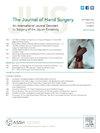Observational Health Data Science and Informatics and Hand Surgery Research: Past, Present, and Future
IF 2.1
2区 医学
Q2 ORTHOPEDICS
引用次数: 0
Abstract
Single center studies are limited by bias, lack of generalizability and variability, and inability to study rare conditions. Multicenter observational research could address many of those concerns, especially in hand surgery where multicenter research is currently quite limited; however, there are numerous barriers including regulatory issues, lack of common terminology, and variable data set structures. The Observational Health Data Sciences and Informatics (OHDSI) program aims to surmount these limitations by enabling large-scale, collaborative research across multiple institutions. The OHDSI uses the Observational Medical Outcomes Partnership (OMOP) Common Data Model (CDM) to standardize health care data into a common language, enabling consistent and reliable analysis. The OMOP CDM has been transformative in converting multiple databases into a standardized code with a single vocabulary, allowing for coherent analysis across multiple data sets. Building upon the OMOP CDM, OHDSI provides an extensive suite of open-source tools for all research stages, from data extraction to statistical modeling. By keeping sensitive data local and only sharing summary statistics, OHDSI ensures compliance with privacy regulations while allowing for large-scale analyses. For hand surgery, OHDSI can enhance research depth, understanding of outcomes, risk factors, complications, and device performance, ultimately leading to better patient care.
观察性健康数据科学和信息学与手外科研究:过去、现在和未来。
单中心研究受到偏见、缺乏普遍性和可变性以及无法研究罕见病症等因素的限制。多中心观察研究可以解决其中的许多问题,尤其是手外科,目前多中心研究还相当有限;然而,多中心观察研究也存在许多障碍,包括监管问题、缺乏通用术语以及数据集结构不一。观察性健康数据科学与信息学(OHDSI)计划旨在通过跨机构的大规模合作研究来克服这些限制。观察性健康数据科学与信息学(OHDSI)计划采用观察性医疗结果合作组织(OMOP)通用数据模型(CDM),将医疗数据标准化为一种通用语言,从而实现一致、可靠的分析。OMOP CDM 在将多个数据库转换为具有单一词汇的标准化代码方面发挥了变革性的作用,使多个数据集之间的分析能够协调一致。在 OMOP CDM 的基础上,OHDSI 为从数据提取到统计建模的所有研究阶段提供了一套广泛的开源工具。通过将敏感数据保存在本地并只共享摘要统计数据,OHDSI 可确保在进行大规模分析的同时遵守隐私法规。对于手外科而言,OHDSI 可以提高研究深度,加深对结果、风险因素、并发症和设备性能的理解,最终改善患者护理。
本文章由计算机程序翻译,如有差异,请以英文原文为准。
求助全文
约1分钟内获得全文
求助全文
来源期刊
CiteScore
3.20
自引率
10.50%
发文量
402
审稿时长
12 weeks
期刊介绍:
The Journal of Hand Surgery publishes original, peer-reviewed articles related to the pathophysiology, diagnosis, and treatment of diseases and conditions of the upper extremity; these include both clinical and basic science studies, along with case reports. Special features include Review Articles (including Current Concepts and The Hand Surgery Landscape), Reviews of Books and Media, and Letters to the Editor.

 求助内容:
求助内容: 应助结果提醒方式:
应助结果提醒方式:


